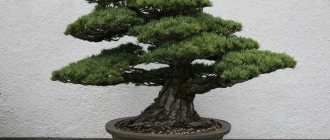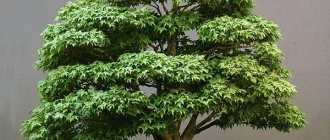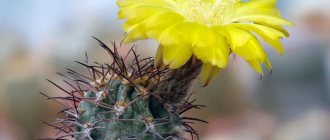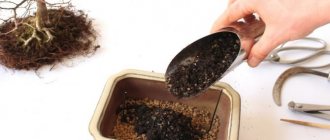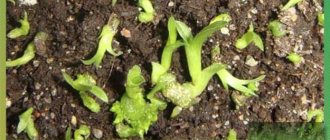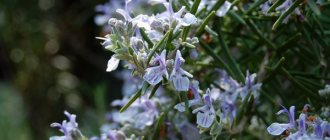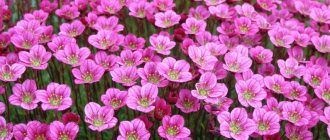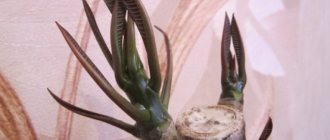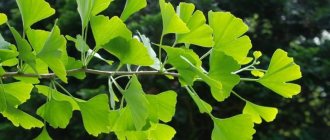Sakura from seeds: preparation for planting
The basis for growing any crop is high-quality seed material. Sakura seeds can be bought at specialized retail outlets. Seed germination is poor - no more than 20%. On this score, gardeners advise:
- buy more material;
- use products from different manufacturers to determine who has better quality.
Sakura seeds
The process of planting a tree requires the following actions:
- Perform stratification. For seeds, you should imitate natural winter weather. To do this, put them in a bag of wet sand and place them in the warmest compartment of the refrigerator. At a temperature of +4...+5 °C the material should be stored for at least 2-3 months.
- A couple of days before planting, soak the seeds for a day in lukewarm water.
- To help seedlings break through the seed coat, scratch or pierce the outer layer mechanically.
Sakura seeds are planted in calcined or otherwise disinfected coarse sand. This substrate is most suitable for germinating seeds and, in addition, will protect the crop from diseases. An alternative to sand is moss or vermiculite. Use a wide and shallow container as a pot. Be sure to have drainage holes.
GROW CHERRY AND DECORATE YOUR GARDEN
In garden design, sakura is used both in single (solitary) plantings and in artistic compositions. It looks very good in combination with rocky hills, walls, next to a pond or a dry stream.
Any composition involving sakura must include stones.
You can buy Taihaku sakura from us. We guarantee high quality and full compliance with the specified parameters of the variety.
There are no real sakura at garden markets. There, at best, you will be offered seedlings of felt cherry, Sakhalin cherry or three-lobed almond ( we talked about it in the article “How to grow almonds in the garden” ).
Trilobed almond is also a very beautiful ornamental shrub with raspberry-pink double flowers. But still this is not sakura!
How to plant and pick sakura at home
Proper planting is half the success of future sakura growing:
- treat the seeds with a fungicide;
- moisten the substrate;
- deepen the seeds half a centimeter into the grooves made (there should be at least 3 cm between them);
- cover the planting with a thin layer of fine-grained sand;
- cover the pot with film or glass;
- leave at a temperature of +5…10 °C.
Attention! Gardeners recommend planting seeds in the spring or at the turn of August and September.
Seedlings should appear in 1.5-2 weeks. Until this point, care consists of keeping the top layer of soil moist, providing plenty of light, and gradually raising the temperature to room temperature. When shoots appear, plant them in separate pots. The distance between seeded seedlings should not be more than 10 cm if you move them to a new common container.
Sakura blossom
Picking is an important condition for the normal development of sakura. Repeated transplants help strengthen the root system. Sakura seedlings are left untouched only in the cold season. They are placed in a cool, shaded room until spring. The key point in picking grown seedlings is the selection of new pots. The gardener has two options:
- leave the crop to grow in a cramped container and form a bonsai version of the tree;
- move it to deeper and wider pots and prepare the tree for the garden.
WHAT IS SHE FROST-RESISTANT SAKURA?
Northern sakura, as a rule, is a low tree, up to 3.5 m high, with large double flowers of pale pink, crimson, lilac or white. In general, classic sakura flowers are dazzling white, up to 6.5 cm in diameter.
There are a lot of flowers. They are collected in large brushes of 8–10 inflorescences, completely covering the branch. As a result, the entire crown looks like one white or pale pink ball, behind which the leaves are completely invisible.
Flowering begins in May and can last for a very long time, and it is simply a miracle. The most beautiful, frost-resistant and long-blooming is the Taihaku sakura.
In addition to all other advantages, it practically does not get sick and is not affected by pests and is considered the most unpretentious in care. Even a novice gardener can grow this sakura!
Sakura is a long-liver. It can grow in one place for more than 500 years. Flowering begins already in the third year. The flowers exude a wonderful aroma and attract a huge number of pollinating insects to the garden.
The leaves of sakura in spring are golden-bronze in color, and by mid-summer they change to dark green. The bark of the tree is smooth, grayish-pink with thin cracks.
The wood of the tree contains a large amount of resin. Therefore, its branches are very flexible, drooping, and perfectly amenable to shaping.
When growing sakura, keep in mind that it grows slowly. That is why its annual seedlings are often planted in bonsai-style gardens along with dwarf pines.
Sakura does not take root very quickly, so it should be planted in the spring or early summer (plants with a closed root system), so that before the fall it is well rooted and has time to prepare for winter frosts.
Features of tree care
Sakura varieties have many differences in cultivation techniques. To grow bonsai sakura, the roots are shortened every season, and horizontal cuts are made on the bark, right on the trunk. For a garden tree, these methods are irrelevant - you form a seedling in a room, and then transplant it into open ground.
The rules for caring for a specific variety differ. A common feature is that trees are capricious and require daily attention. The tree needs soil enriched with humus, potassium, and nitrogen. During the season, sakura is watered with half a glass per day, in winter - less often. The plant needs good lighting and the absence of drafts.
Sakura bonsai
The secret of the beauty of sakura is not only in large and abundant flowers, but also in the aristocratically built crown. It can be formed starting from 2-3 years of age of the plant. In the natural and miniature versions, the branches are arranged according to the same pattern. The crown can mean a straight trunk, a bend in the spirit of centuries-old Japanese cherry blossoms, or widely spread branches.
Advice. To create a wide crown, prune the main shoot when you think it is tall enough. You can also trim the side shoots to correct their direction.
Description
If not every, then every second gardener has probably dreamed of growing sakura at home, because this beautiful tree is so pleasing to the eye with its delicate blooms. In China and Japan, as well as in most Asian countries, this variety of cherry is much more widespread than in Russia, and Asians admire the tree no more than Russians admire oak. Nevertheless, even in more severe climate conditions (in the Moscow region, St. Petersburg and even in Siberia) this beautiful plant can be grown. To find out how to do this correctly, we recommend taking note of the tips in our article.
How to prune bonsai sakura correctly
To grow miniature crops, experts use various tricks and techniques. The goal is to make even a young tree look like a hundred-year-old tree. For this:
- Expose some of the roots by removing a small layer at the base of the trunk. It should be thick. To do this, regularly remove all vertically growing shoots.
- The barrel should not be too long. Cut off part of the root at its base. When replanting, deepen the cutting area into the ground. Over time, new roots will grow on it. Then the tree can be picked again, removing the old rhizome.
- The heaviest branch of the tree will be the bottom one. Which shoot to leave for its formation - decide based on the compositional idea.
- For a broom-shaped crown, prune vertically growing branches as much as possible. For a vertical one, on the contrary, protect vertical branches. In this case, only horizontal ones are cut.
The bonsai tree needs all these manipulations constantly. Otherwise it will lose its shape. The gardener's goal is to maximize the decorative effect of sakura. If you adhere to cultivation technology, provide the plant with a little care and attention every day, then the Japanese guest will delight you with lush, large and bright colors every spring.
Varieties
There are more than 400 varieties of sakura.
Most of the species are used only for decorating the site, but some can bear fruit. There is a known variety that is capable of producing edible cherries. There are finely serrated, ferruginous, Sakhalin and short-bristled sakura.
Ferruginous cherry is found in China, Korea and the Primorsky Territory. The tree grows up to 1.5 meters in height and is used exclusively for decorative purposes. It is quite unpretentious, and therefore is in great demand among summer residents. Some types of ferruginous cherries bear edible fruits that can be used in cooking.
- Small-serrated sakura is distinguished by its tall growth and large leaves. In autumn, the crown acquires a bright pink and purple color. This plant blooms with large white-pink flowers, forming inflorescences 15-20 cm in diameter.
- The short-bristled cherry is not very tall and grows on average up to 8-10 m. The plant blooms with light pink flowers, forming inflorescences with a diameter of 2.5 cm.
Sakhalin sakura is distinguished by a spreading crown and grows above 8 m. The crop stands out for its bright red leaves, which in the autumn acquire a rich burgundy hue.
Let's look at the description of the most popular varieties.
- "Kanzan" is the result of crossing finely serrated sakura and decorative plum. The variety is native to Japan, but can be found in Korea and China. The shrub grows no higher than 11 m in height and has a trunk diameter of 5.5 m. The wide crown is represented by elliptical green leaves, which acquire an orange tint in autumn. "Kanzan" blooms in mid-spring with double pink flowers, and in the summer it bears a harvest in the form of small black cherries that have a bitter taste.
- "Kiku Shidar" is a low-growing shrub whose height does not exceed 6 meters. The crown is represented by large elliptical green leaves. When autumn comes, they acquire a yellow tint. The culture blooms in mid-spring with dense pink inflorescences consisting of 3-5 flowers. "Kiku Shidar" is not afraid of frost and can withstand temperatures down to 30 degrees. The variety is disease resistant and usually grows in moist, slightly acidic soils.
- "Royal Burgundy" - grows up to 10 m in height and has a cone-shaped crown. The pointed leaves of the variety have a bright purple hue, turning yellow in the fall. The plant blooms in early May with large double flowers of a soft pink hue. "Royal Burgundy" does not bear fruit.
- “Gummi” is a distant relative of sea buckthorn and is distinguished by small red cherries that can be eaten. The fruits have a sweet and sour taste and are rich in vitamins, so they are often used to make compotes and jam. The plant itself is 1 m high and blooms with gray-yellow flowers that exude a pleasant aroma.
In addition to these varieties, varieties such as “Fuyu-Zakura”, “Yama-Zakura”, “Someyoshino”, “Yae-Zakura” and “Kasumi-Zakura” are very popular. They all differ in the shape and shade of flowers and leaves, and also have different heights.
Growing a tree from seedlings
How to grow bonsai from seedlings? When the sprouts reach a height of 4-7 cm, plant them in wide bowls filled with a mixture of peat, sand and humus garden soil. Plant roots that are too long should be shortened slightly with garden shears. Planting material must be deepened into the soil up to the first pair of leaves. The distance between seedlings should be at least 10 cm. Young plants must be watered regularly.
As the seedlings grow, they need to be pricked repeatedly. Diving is the transplantation of plants into individual containers in order to expand the area and improve nutrition of the roots. Thanks to multiple transplants, a powerful, well-developed root system of young trees is formed.
For the winter, bonsai seedlings are placed in a cool place or left indoors on a cold windowsill behind a thick curtain. The plant is not touched until spring. In the spring, the dive continues. It takes 2-3 years to grow sakura. Only then will it be possible to begin forming a tree at home.
The rules for crown formation are as follows:
- 1The bonsaist’s task is to constantly restrain the growth of the tree and give it its characteristic dwarf shape.
- 2The trunk at the base of the tree should be thick. To achieve this effect, all shoots with a vertical direction of growth are pruned.
- 3A bonsai plant should look like a century-old tree, even if it is only 3 years old. To give the tree a characteristic appearance, the upper part of the roots is exposed. To do this, the top layer of soil is removed.
- 4At what level to start forming the crown, the bonsaiist decides by cutting off the lower branches. The first strong branch of the trunk will be the lowest one, not cut by the bonsai plant.
- 5The trunk is too long and needs to be shortened. To do this, cut off a circular strip of bark at the base and replant the tree, plunging the bare area into the ground. Roots later grow in this place. Old roots are cut off and the plant is replanted.
- 6If the broom style is chosen, vertical branches are trimmed as much as possible, allowing horizontal shoots to bush. If the vertical style is chosen, upward growth of the main trunk and side branches is encouraged.
- 7An already formed bonsai tree needs to be constantly pruned and pinched to maintain its ideal shape.
Preparatory activities and planting
Each type of plant has its own method of planting seeds. Beech, spruce, oak, fir and pine seeds are ready for planting immediately after collection. If planting is planned for another time, the planting material should be placed in a container (can be wrapped in a piece of cloth) and placed in a cool, dark place for storage until planting.
How to grow bonsai from sakura seeds? Sakura is an ideal tree for bonsai. Its seeds have a dense shell, so germination is more difficult. Japanese cherry seeds require a period of dormancy and stratification. Stratification is the process of keeping seeds for a long time at a certain temperature to speed up their germination. To stratify, sakura seeds need to be placed in a refrigerator for 3-4 months, in which the temperature is set at +4...+5 °C.
On the eve of planting, the seeds are soaked in warm water (25-30 °C) for 1 day. It is advisable to add a fungicide to the water to prevent fungal diseases. Spring, late summer and early autumn are best for planting seeds at home.
- ErnstErnst: “I threw Malakhov to hell after the broadcast about “sore joints”! He dared...
>>
Sakura seeds are sprouted in coarse sand. It is recommended to calcinate or steam it before planting the seeds. Disinfection of the soil will protect plants from disease and death. There is no need to add fertilizer to the soil. The container for planting seeds should be wide, 5 cm deep. It should have drainage holes.
Prepared sakura seeds are planted in grooves made in well-moistened sand. During planting, it is advisable to slightly break, cut or puncture the hard shell of the seeds. This will help them grow faster and more friendly. The distance between the grooves should be at least 3 cm. The planted seeds are covered with fine sand on top. The thickness of the top layer of soil should be 2 diameters of the bone.
Seeds for germination can also be immersed in moist vermiculite or sphagnum moss. After planting the seeds, the container is covered with film or glass and placed in a cool place (plus temperature from 5 to 10 °C) for 1.5-2 weeks. The film will provide the high soil moisture necessary for germination. To prevent mold from appearing, you need to do regular ventilation. When the first shoots emerge, the film or glass is removed. The container with the sprouts is placed in a lighted place (not in direct sunlight).
Average prices
In material terms, growing sakura bonsai is no more expensive than growing any other indoor plant. Seeds in bags of 8 - 20 pieces cost about 100 rubles . However, if you want to buy an adult sakura tree, you will have to pay at least 10,000 rubles.
Sakura bonsai seeds can be bought in supermarkets that sell gardening supplies. Meanwhile, experienced flower growers try not to do this and purchase them in specialized stores from trusted sellers. Cuttings can be found from gardeners who breed sakura.
Online stores often come to the rescue. Foreign trading companies have a particularly rich variety of varieties. However, you should be careful here - as practice has shown, Ali Express does not always sell high-quality planting material.
Features of reproduction
Bonsai can be propagated not only by seeds, but also by cuttings. The procedure is recommended to be performed in spring or summer.
- To do this, select a twig 2–5 millimeters thick and 5–7 centimeters long and make an oblique cut with sharp scissors.
- After this, the cuttings are treated with a composition that promotes rooting, placed in the ground and watered.
- After a few weeks, the plant is transferred to a permanent location.
What kind of plant is this?
It is customary to call the Japanese cherry tree sakura, however, botanists will not agree with this.
Reference .
Sakura is the collective name for varieties that were isolated on the basis of several East Asian species. They are distinguished by the presence of pink, usually double flowers. Japanese cherry is a plant called "serra serrata". Most varieties of sakura are cultivated from the small serrated cherry tree (Cerasus serrulata). Under natural conditions, this tree is about twenty meters high with large leaves, found in some areas of China, the Korean Peninsula and Japan.
The cherry blossom period lasts no more than ten days, but different varieties of cherry blossom delight the eye with their buds blooming from March to June. Despite the fact that sakura is considered to be an exclusively ornamental plant, it produces small but sweet fruits.
Bonsai is a miniature tree that reproduces the same characteristics as a tree growing in natural conditions. Using special techniques, they form a bizarre-shaped plant up to 130 centimeters high. Today there are varieties of sakura bonsai that have not only a natural pink color, but also red, purple and their shades.

